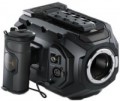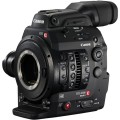Number of megapixels
The total number of individual photosensitive points (pixels) provided in the design of the sensor (1 megapixel corresponds to a million pixels). This parameter takes into account both those points on which the light falls, and service points that are not directly involved in the construction of the image. Therefore, in modern video cameras, it is more of a reference than practically significant; the actual image quality depends primarily on the number of effective megapixels (see below).
Effective megapixels
The number of light sensitive pixels directly involved in the construction of the image. These are the dots on which the “image” projected by the lens onto the matrix falls. In addition to them, there are also service pixels that are not illuminated during camera operation — they provide auxiliary information necessary for processing the resulting image. Also, when calculating effective megapixels, the reserve area required for electronic stabilization is usually not taken into account (see "Image Stabilization").
The value of the number of effective pixels for different modes of operation of the camcorder will also be different. For example, when recording video, many cameras use multiple pixels to build a single dot on the image; this is due to the fact that the sensor resolutions significantly exceed those required for video shooting (for example, the Full HD standard technically corresponds to only 2.07 megapixels). As a result, the image quality depends more on the sensor size (see above) than on the resolution. And among sensors of the same size, high resolution allows user to get better colour rendering and higher clarity (however, not always — a lot also depends on the peculiarities of image processing). If we are talking about photography, then more megapixels means a higher resolution of the resulting image, but the quality of such a picture can be relatively low due to the increased noise level and low sensitivity of each individual pixel.
Image stabilization
An image stabilization method provided in the design of a video camera. The stabilization function itself is designed to compensate for small camera shakes so that they are not noticeable in the image. This is especially true when shooting handheld, and in fact most modern models are designed specifically for such usage. According to the method of work, there are such options:
—
Optical. A special mechanism with a system of gyroscopes and movable lenses, installed directly in the lens, is responsible for the operation of such stabilization systems. It introduces a correction for all tremors, vibrations, etc., and the “picture” falls on the already stabilized sensor. Optical systems are considered the most advanced and efficient, because. their work allows you to use the entire area of the sensor, fully exploit its capabilities and provide good image quality. Among the shortcomings, it is worth noting the increase in the cost and weight of the cameras, as well as a slight decrease in the reliability of the optics. At the same time, these moments are most often not critical, and stabilizers of this type can be used even in simple and inexpensive models.
— Electronic. Electronic stabilization is carried out due to the fact that not the entire area of the sensor, but only some of it, is involved in the formation of an image for a frame. Simply put, the camera electronics "takes into account" a certain area of the sensor and
...transfers the image from it into the frame; and at small displacements, this "area of attention" is also displaced, due to which the visible image remains motionless. The advantages of electronic systems are simplicity of design, lightness, compactness and high reliability; they can be used with even the simplest lenses installed in pocket cameras (see “Features”). Their main disadvantage is the need to reserve a part of the sensor, which reduces the size and resolution of the actually involved area and adversely affects the image quality.
— Optical / electronic. In such systems, both the methods described above are used — both the mechanism in the lens and the reserve on the sensor. This provides extremely high vibration compensation efficiency — the image remains stable even in such conditions in which any single method would be useless. On the other hand, the disadvantages of both options also remain relevant, and the cost of cameras with this feature is quite high.Frame frequency
The highest frame rate provided by the camera when shooting video. The minimum frequency for normal viewing is the classic 24 fps used in cinema. At the same time, most modern video cameras are capable of providing up to 50 – 60 fps, and even higher frequencies can be used for the slow motion effect.
In fact, this indicator is important primarily when shooting dynamic scenes. The higher the frame rate, the smoother the fast motion will look in the frame, the less jerky it will be and the more pleasant the overall impression of the image will be. The reverse side of this is an increase in the size of recorded files (all other things being equal). Therefore, the frame rate can be made adjustable so that the operator can choose the best option for a particular situation.
Recording formats
Video file formats that the camera can use to store recorded footage. If you want to view these materials using a separate device (player, media centre, etc.), you should make sure that this player supports the appropriate formats, otherwise conversion may be necessary.
Video recording speed
The data transfer speed provided by the camera when recording video. This parameter is also called bitrate (i.e., the number of bits per unit of time). For any file format used for recording, the general rule is that the higher the bitrate, the better the image quality (especially for formats that use lossy compression). On the other hand, high speed have appropriate requirements for the capabilities of the memory cards used — for more details, see "Memory card support"; and it increases the size of the file accordingly. Therefore, many modern camcorders are able to work with different bitrates; this allows you to choose the best option depending on what is more important for you at the moment — maximum quality or the ability to work with a slow card.
At the same time, we note that in terms of quality, this parameter is important mainly for professional video shooting. If you need a camera for amateur purposes, there is no need to look for the maximum bitrate: after all, such models (and memory cards for them) cost accordingly.
Shutter speed
The range of shutter speeds in which the camera is capable of operating during the shooting process.
Initially, shutter speed is the time during which light affects the photosensitive material (film) when shooting a single frame. For digital sensors, this is the period of time during which an image is read from the sensor to build a separate frame. When shooting video, this interval cannot be more than 1/n, where n is the frame rate (see above), but it can be less — for example, shooting at a frame rate of 30 fps and shutter speed of each frame 1/60 s. There are no such restrictions for the photo mode.
Long exposures are good because they allow the sensor to take in more light — accordingly, the “picture” is brighter, which is especially important in low light. At the same time, they increase the likelihood of getting a blurry image — due to the rapid movement of objects in the frame, the operator's hand shaking and other random camera movements that even the stabilization system is unable to compensate for. This effect can be useful for artistic motion blur, especially when shooting video, but in photo mode it is most often undesirable. Fast shutter speeds, on the other hand, allow you to get clear shots, but with less light, and in the case of video, even with the effect of sharp, jerky movements.
Accordingly, different exposure time options will be optimal for each situation, and the wider their range, the more opportunities the came...ra has to adjust to specific conditions.
White balance
Presets and white balance adjustment modes provided by the camera.
White balance is a characteristic that describes the qualities of the lighting of the scene and the distortion that this lighting introduces into the colours perceived by the camera. Its used because modern digital sensors are unable to independently adjust to different light sources, as the human eye does. In fact, this means that the same object shot under lighting with different colour temperatures (for example, under a “warm” incandescent lamp and a “cold” fluorescent lamp) will look different without adjustment. To avoid this, the white balance setting is applied.
The main options for such a setting used in modern cameras are as follows:
— Auto. In accordance with the name, in this mode, the camera electronics independently evaluates the specifics of the illumination of the scene being shot and makes appropriate corrections to the colour reproduction. This adjustment is the most convenient for the operator, because. does not require any additional actions from him — everything is done by automation. At the same time, no such adjustment system is perfect, and does not always provide 100% white balance for the current situation. Therefore, even in the simplest models like pocket ones (see "Features"), this option is rarely the only one, not to mention professional equipment.
— Presets. The ability to select white balance from several options that correspond to...standard shooting conditions — for example, “sunny day”, “cloudy”, “fluorescent lamp”, “incandescent lamp”, etc. Such a system is quite simple even for inexperienced users and at the same time quite reliable and versatile, although its specific capabilities directly depend on the number of presets.
— Manual. Manual white balance setting assumes that the operator himself “tells” the camera which object to consider pure white — based on this, the electronics calculate the lighting characteristics (unlike automatic mode, when the reference object is also determined without user involvement). The easiest way to do this is to use a regular sheet of paper, but the procedure also works with neutral grey objects. Manual mode allows you to very accurately set the white balance for a particular scene, but it requires some time and appropriate skills — and therefore is used mainly in professional camcorders.
— Temperature control. This function allows you to set a specific value for the colour temperature of the light source (in kelvins) — it is this temperature that will correspond to the white balance when shooting. This setup format is faster and more convenient than manual setup, but is not widely used. This is due to the fact that it is well suited only for studio conditions, where the characteristics of each light source are precisely known — in other cases, manual adjustment is usually more reliable.
Pre-recording (Pre-Rec)
Camera has a
pre-recording (Pre-Rec) feature.
This feature makes life significantly easier for the operator in conditions where speed of reaction is important — it reduces the risk of missing the moment by being late with the start of the recording. In fact, Pre-Rec allows you to start filming a few seconds (usually 2-3) before the record button is pressed. This is due to the fact that with the pre-recording mode enabled, the camera constantly captures the last few seconds "seen" by the lens in the buffer, and when recording starts, the video from the buffer is attached to the beginning of the recorded file — this creates the effect of a "time machine".

